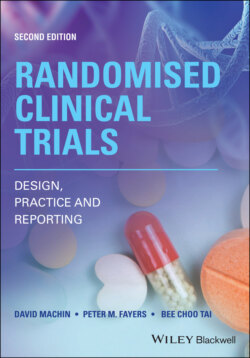Читать книгу Randomised Clinical Trials - David Machin - Страница 106
Example 3.16 Protocol EXPEL (2016): Peritoneal lavage after curative gastrectomy Enrolment and randomisation
ОглавлениеHaving obtained informed written consent, potential subjects will then undergo surgery. If the patients are confirmed to have cT3 or cT4 disease and are amendable to radical gastrectomy with curative intent, they will be formally enrolled into the study and undergo randomisation. Study participants will be randomised to EIPL arm or standard arm based on random permuted blocks with varying block size of four and six, assuming equal allocation between treatment arms. The randomisation is stratified according to individual study site. A web‐based randomisation programme (https://rand.scri.edu.sg/) will be utilised to facilitate randomisation. The treatment code will be disclosed to the surgeon only at the end of gastrectomy. EIPL or standard lavage will then be performed according to the treatment code. The abdomen will then be closed as per standard.
The method of obtaining the randomisation that is chosen will depend on circumstances but the trend is now towards more automated systems. However, this trend does not preclude simpler – yet reliable approaches that are likely to be more viable for trials of modest size. The SQCP01 (2006) protocol for management of clefts of the secondary palate in infants provided for both a telephone‐ and a web‐based randomisation option.
The use of sealed envelopes by the clinical teams, as opposed to contacting a trials office remotely, is not regarded as an optimal method of allocation and should be avoided if at all possible. Whenever employed a clear justification for this is required. In the case of the investigators concerned with SQGL02 (1999) the nature of AACG, with its sudden onset and devastating consequences, provides the rationale.
